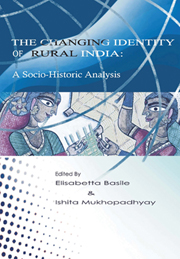Book contents
- Frontmatter
- Contents
- Acronyms and Abbreviations
- About the Authors
- INTRODUCTION
- PART 1 INDIAN RURAL TRANSFORMATIONS
- PART 2 INEQUALITY IN RURAL INDIA
- Social Capital and Poverty Reduction Strategies: The Case of Rural India
- An Overview of Indian Microfinance
- Income-based Estimates vs Consumption-based Estimates of Poverty: Evidence from Rural Tamil Nadu after Liberalization
- Occupational Diversification of the Rural Workers: Some Results from Field Surveys in West Bengal
- Literacy and Externalities in Human Development
- PART 3 SOCIAL MOVEMENTS AND IDENTITIES
- Appendix 1 Socio-Economic Indicators of Rural India
Social Capital and Poverty Reduction Strategies: The Case of Rural India
from PART 2 - INEQUALITY IN RURAL INDIA
Published online by Cambridge University Press: 05 March 2012
- Frontmatter
- Contents
- Acronyms and Abbreviations
- About the Authors
- INTRODUCTION
- PART 1 INDIAN RURAL TRANSFORMATIONS
- PART 2 INEQUALITY IN RURAL INDIA
- Social Capital and Poverty Reduction Strategies: The Case of Rural India
- An Overview of Indian Microfinance
- Income-based Estimates vs Consumption-based Estimates of Poverty: Evidence from Rural Tamil Nadu after Liberalization
- Occupational Diversification of the Rural Workers: Some Results from Field Surveys in West Bengal
- Literacy and Externalities in Human Development
- PART 3 SOCIAL MOVEMENTS AND IDENTITIES
- Appendix 1 Socio-Economic Indicators of Rural India
Summary
This paper discusses the role of social capital as a policy tool against poverty and inequality in the development strategies enhanced by international agencies in rural India.
In spite of the important results in economic growth, rural India still shows a very high level of poverty and inequality. Moreover, many scholars (Morris, 1998; Krishna, 2003; and Dowla, 2006) have focused on the lack of social capital to account for the increasing gap between rural and urban India, pointing out that social capital exerts a deep influence on development processes, especially in rural areas. Finally, many international agencies have launched, in rural India, development projects in which social capital is seen as a strategic variable.
We argue that the role played by social capital in development processes suffer from some sorts of ambiguity. It is not clear whether the lack of ‘good’ social capital can be considered in theoretical terms as a main cause for the failure of development strategies, or it is only one among other causes. Moreover, there is some evidence (see below) that social capital is not influent at all, and that, due to ‘bad’ quality, can become an obstacle to growth. At the same time, from a policy point of view, a careful reading of programmes and reports of international organizations shows a basic incoherence between the verbal emphasis on social capital and the actual role that is assigned to it.
- Type
- Chapter
- Information
- The Changing Identity of Rural IndiaA Sociohistoric Analysis, pp. 65 - 95Publisher: Anthem PressPrint publication year: 2009



